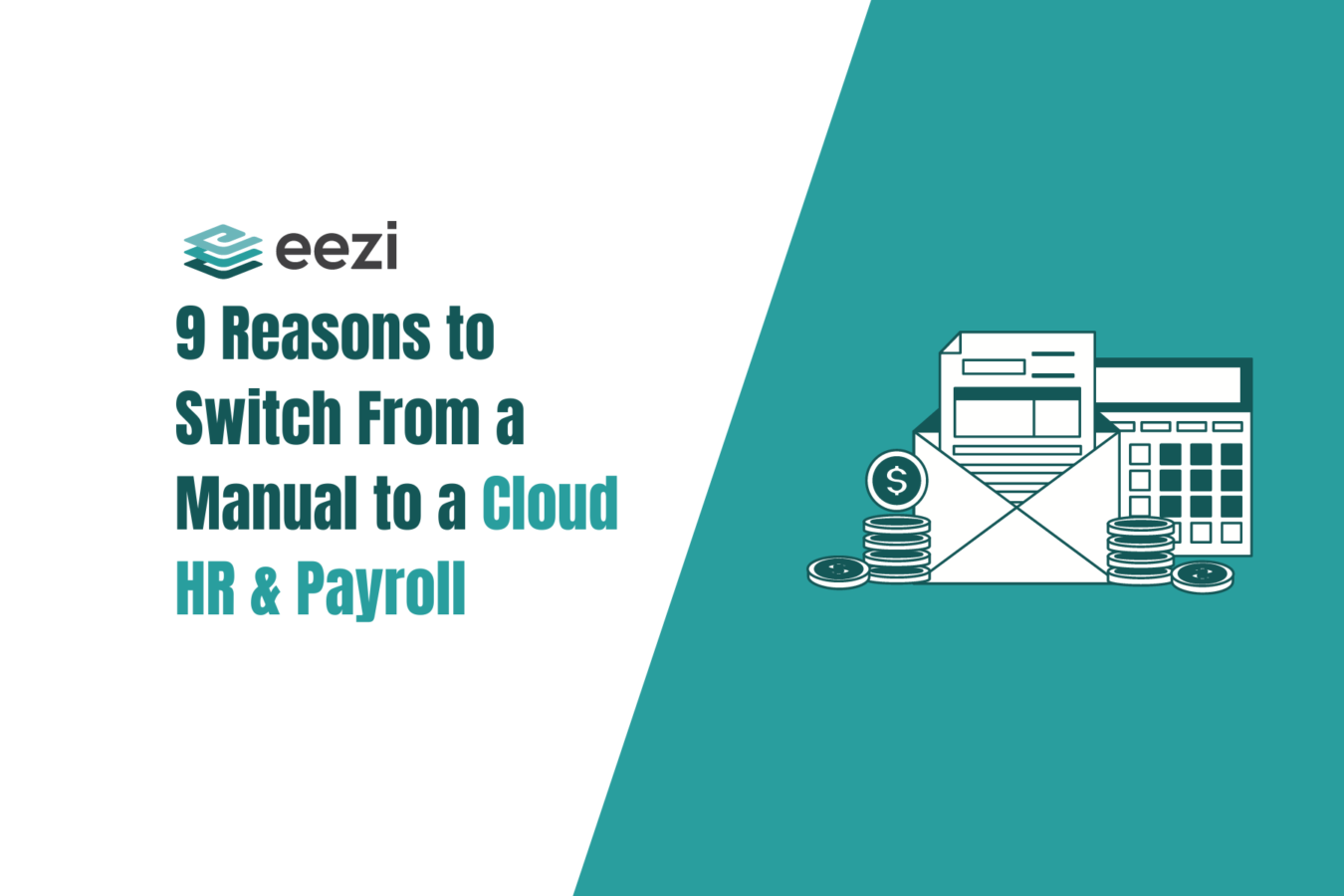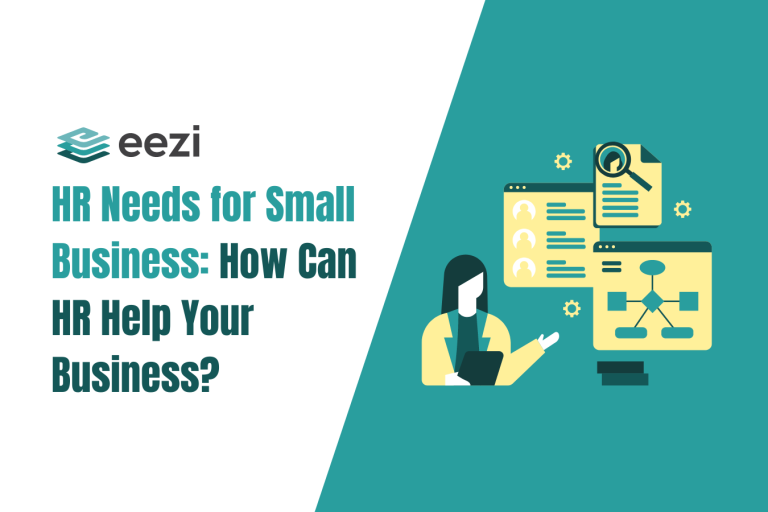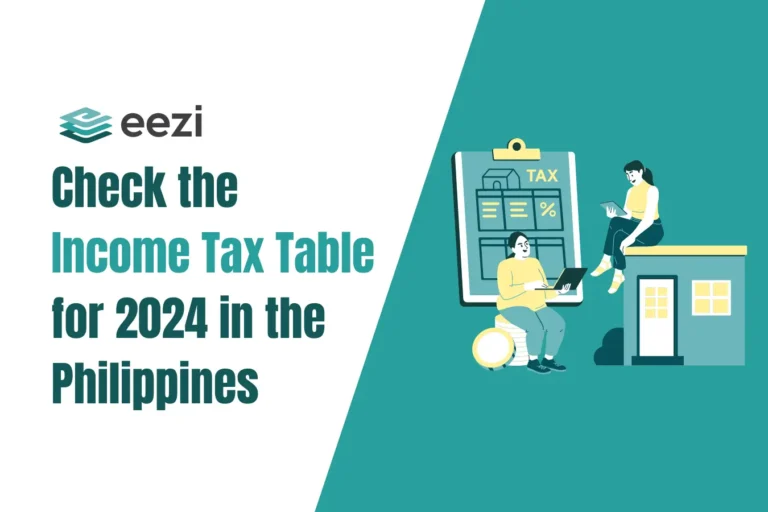Below are the reasons why enrolling in a cloud-based HRIS and payroll software can benefit your company.
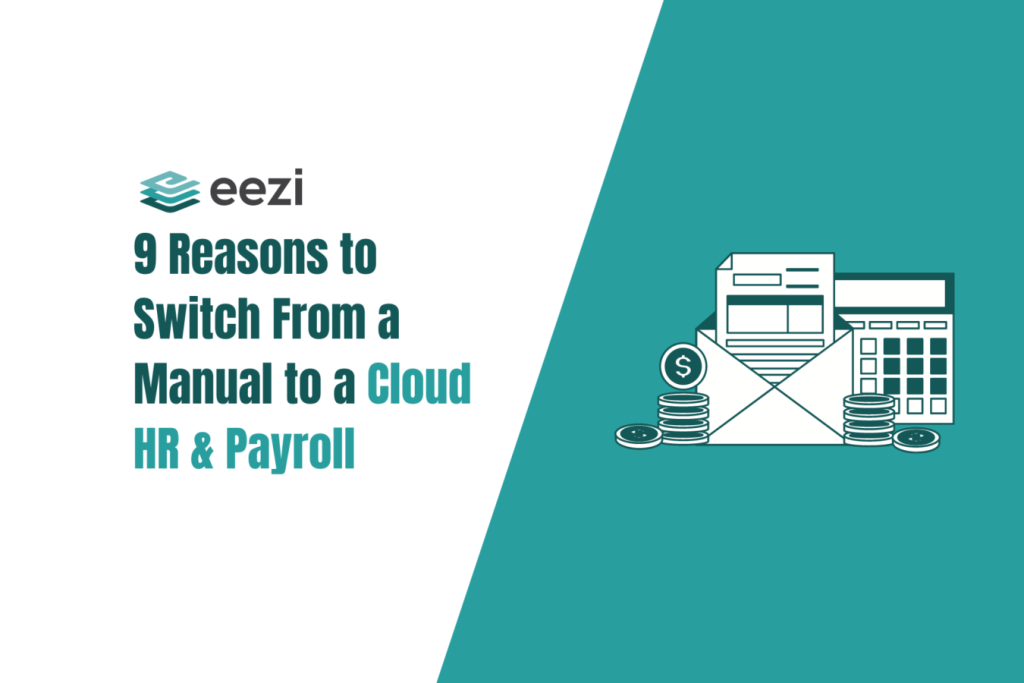
An HR specialist’s work can be extremely tedious, especially without the help of technology. Imagine poring over numerous time cards, record books, and ledgers before payday so you can run payroll.
On top of that, you need to manually compute 100 employees’ salaries, deductions, contributions, and other compensations. More importantly, you need to do it as accurately as possible, lest you earn their ire.
From Spreadsheets to HR Software
With the introduction of spreadsheets, HRs no longer had to compute manually. However, using spreadsheets alone cannot remedy the concerns with other HR processes, especially managing employee data. With HR software, the work delegated to HR becomes even lighter.
Human Resources Information Systems (HRIS) and payroll software are good fits for this situation in order to form a larger human resource management system (HRMS). HRIS systems include document management, payroll management, benefits administration, and attendance.
Below, we explain the benefits of shifting from manually running payroll and HR matters to using payroll and HRIS software. But before that, let us first define payroll software and Human resources information systems (HRIS).
Check out eezi’s HR and payroll software with free trial options.
eezi HR Guide
Learn the efficient ways to set up your HR department.
What is payroll software?
Payroll software manages the payroll process of each employee in a business. The payroll process includes computing gross pay, calculating payroll taxes, other deductions, and mandatory contributions, determining net pay, and then releasing employee compensation. Tax deductions are essential to the payroll process, as tax laws mandate them.
For this article, the terms “payroll software,” “payroll system,” “payroll system software,” “payroll management system,” and “system” will be used interchangeably.
How does payroll software help the business?
Payroll software can perform all steps of the payroll process. It only requires the proper configuration and formulas to comply with tax laws. Besides minimizing the window for human error, the utilization of payroll and HRIS software gives the human resources management team more time to focus on tasks that lead to better business decision-making. This in conjunction with HRIS software can improve your human resources management system.
What is an HRIS?
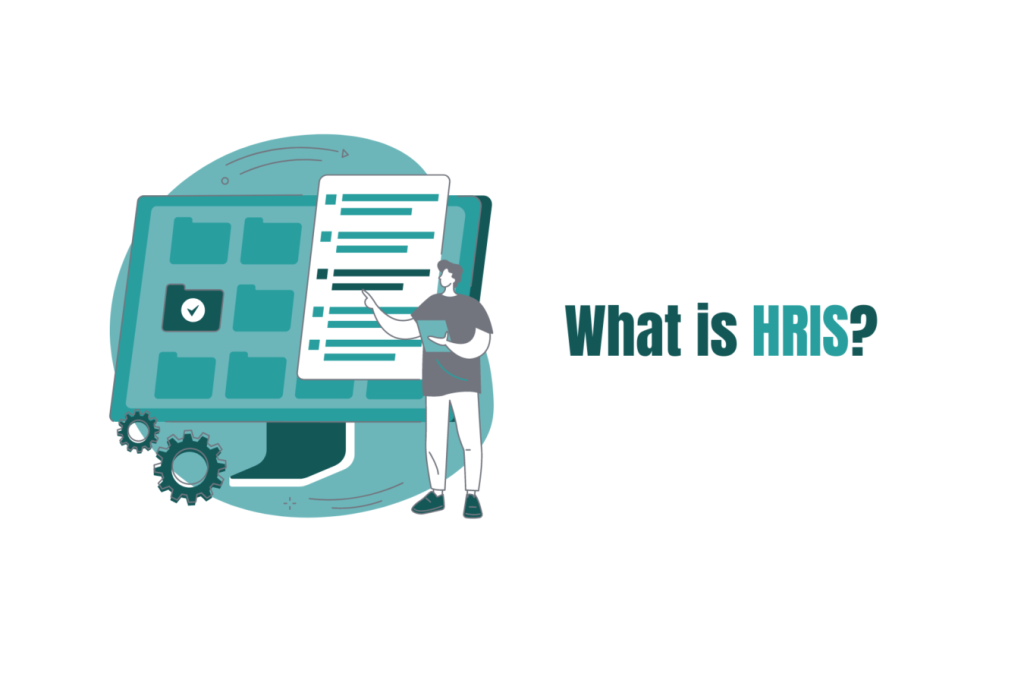
Human resource information system or HRIS software can handle the various tasks delegated to the business’s human resources department. This includes employee database maintenance, payroll management, human resources management, employee attendance tracking, employee engagement, and even filing taxes. Essentially, an HRIS software is a collection of different modules and features that help HR professionals perform their functions.
What are the components of an HRIS, and what do they do?
Payroll management comes in the form of the payroll system mentioned above. The payroll system is integrated into HRIS and is in charge of payroll processing. Payroll systems not only manage employee compensation but also ensure tax compliance.
Human resource management
Human resources management includes collecting, recording, and filing employee information. Employee information usually consists of basic information like full name, birthdate, address, and other contact information. It also includes the hire date, the compensation and benefits, and additional pertinent work information.
Attendance monitoring
To manage employees effectively, HRIS also monitors the attendance of enrolled employees. This includes tracking each employee’s time in and time out and then deriving the employee hours from the gathered data. Employee hours are an essential part of payroll processing. Attendance monitoring also includes absence management, which tracks the filed and approved leaves and time offs.
Tax filing
Finally, HRIS also helps with tax filing. HRIS can incorporate the tax forms necessary for filing the taxes of the business and the employees. Filing taxes is an integral part of the duties of the HR department as it is the responsibility of all business owners and salaried employees to pay taxes, and the business must remit the tax withholdings from the employees. HRIS can also provide reminders of approaching deadlines to file taxes to avoid getting penalties.
Reasons to use an HRIS and payroll system software
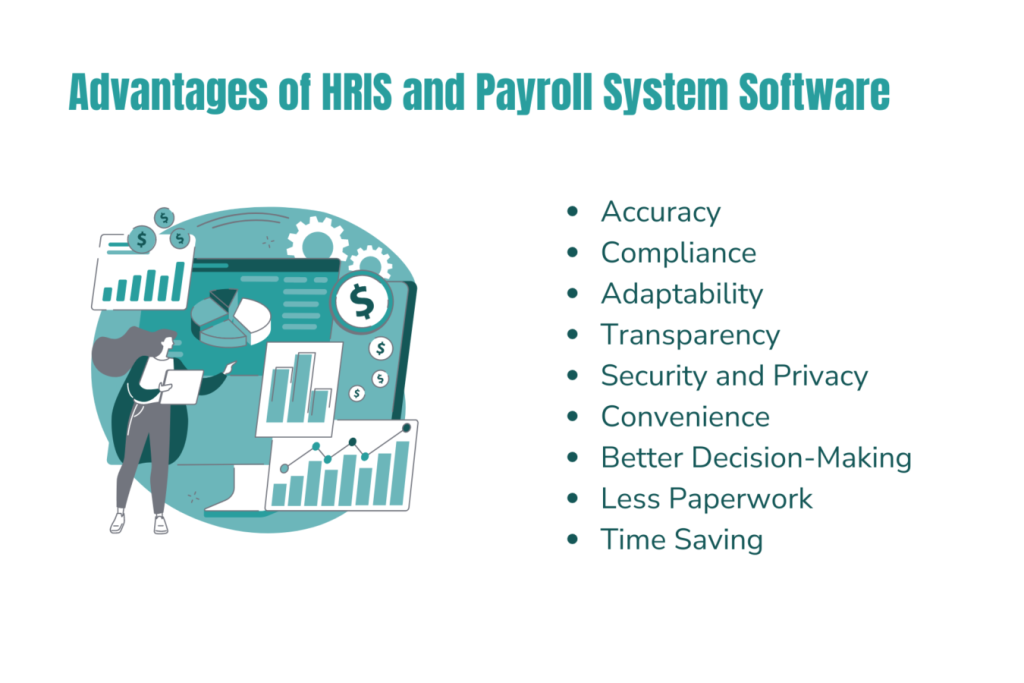
There are many reasons to convert from manually performing payroll and HR duties to using HRIS and payroll software.
Accuracy
Many small businesses are owned and run solely by their owners. These owners usually handle all business matters, including HR duties, and this is typically done manually. The manual method is susceptible to human errors, especially with computations. These errors cause problems for the business, both in budgeting and employee relations, and these problems increase as the business grows.
Switching to HRIS and payroll software is an easy way to avoid these financial and payroll errors. The correct formulas and configuration eliminate the need for manual computations and, in turn, eradicate mistakes. Using HRIS as an in-house payroll system is also cheaper than hiring payroll services from another company.
Compliance
Many businesses are run aground due to their failure to pay taxes on time or at all. Even well-established companies and operations close down when the BIR and COA discover their negligence in paying taxes and file cases for tax evasion.
Using HRIS and payroll software as the in-house payroll system helps ensure the business complies with tax laws. HRIS can provide the necessary tax forms, proper computations for tax withholdings from the employees, and even customize notifications of deadlines so that the HR department can file taxes on time. HRIS and payroll software help the business stay on the law’s good side and avoid legal infractions or penalties.
Adaptability
Small businesses still employing the manual method of doing HR and payroll processes may be doing fine despite some human errors, given that the scope of the operation doesn’t grow. But what if the business demands expansion? Just imagine adding, say, 25 new employees to your business as you open a new branch. How would your HR duties fare?
With HRIS and payroll software, such dilemmas are easy to avoid. Adding a new location that may have different regulations is not a problem for the software. Adding a large number of new employees to the system is also of no consequence. The software can still perform its functions regardless of whether there are 10 or 50 employees.
Transparency
One of a business’s significant expenses is paying employees. Therefore, there must be no room for mistakes in this area, and management can see where the money goes. Recorded documentation of transactions is also kept safely for reference or later perusal.
HRIS can store pertinent records of transactions conducted within its bounds. Anyone with authority can recall and pull up these records. Documents containing essential employee information are also recorded within the system and are trusted to be th
Security and Privacy
Documents and information handled by the HR department may be sensitive, confidential, or personal, and it would not be wise to have them accessed by just anyone in the company. Using logbooks and spreadsheets does not guarantee much safety from unwanted and unauthorized attention.
HRIS and payroll software guarantee that only authorized personnel can access these confidential files. The government now holds the privacy of individuals in high regard, and laws are in place to protect it. Using the system guarantees that private information remains private.
Convenience
A business owner using the manual or spreadsheet method needs to constantly bring their record books and spreadsheets in case of sudden decision-making scenarios or HR work that needs to be completed immediately. If your business has accumulated many records, always carrying your spreadsheets and documents will be a big hassle.
As long as online or cloud-based HRIS and payroll software are utilized, accessing needed records becomes faster and more convenient. HR management also becomes more accessible, as the HR team can work remotely.
To access the system, you only need a computer or an Android or iOS phone connected to the internet. HRIS and payroll software also serve as employee self-service portals, allowing employees to access their accounts and log in remotely, improving the employee experience.
Better Decision-Making
One of the most crucial steps toward any business’s success is steady and sound decision-making. Good decision-making stems from having a well-informed and knowledgeable decision-making body. Having comprehensive and accurate reports and records is vital to this.
When you utilize the HRIS and payroll software solution, comprehensive and accurate reports and records are readily accessible. The system is customizable to produce the reports you need and want, reflecting the necessary trends in your chosen form of a graph, chart, or table. Records are retrievable from the system’s servers at any time.
These readily accessible reports and records allow the decision-making body to see data trends, make the best decisions, and develop the most appropriate HR strategy, focusing on areas that most need it.
Less Paperwork
When you run payroll manually and other HR processes, you can expect the amount of paper to pile up over time. Eventually, all those documents will cost you space and organization. Not to mention, paper-based documents are susceptible to damage. Anything from flood to fire to ants and worms can destroy these vital documents.
Using HRIS and payroll software solutions avoids these problems. HRIS and payroll systems are usually cloud-based solutions with a centralized server, which lessens, if not completely removes, the need for actual manual writing. It also prevents the documents from getting damaged, taking up too much physical space, and getting messy or disorganized.
More Time
Most parts of the HR department’s role in a business take quite a long time, especially running payroll. Accomplishing even the essential payroll functions using the manual or spreadsheet method may take half the payroll period, especially for many employees.
Taking these tedious and time-consuming tasks away from the HR team boosts their productivity. It lets them be more efficient as they now have more time to dedicate to other assignments that will take the business further into success. Employing the services of HRIS and payroll software systems does precisely this. It performs the necessary payroll and HR processes so the HR team doesn’t have to.
Related:
eezi HR Guide
Implement a new HRIS system like a pro!
What do you consider in choosing which HRIS and payroll software to use?
Many HRIS and payroll solutions are now available for any business to employ. They come with a whole range of features and a range of prices. But the question is, “Which one do you pick?”. Here are some factors you should look into to get the most suited HRIS and best payroll software for your business.
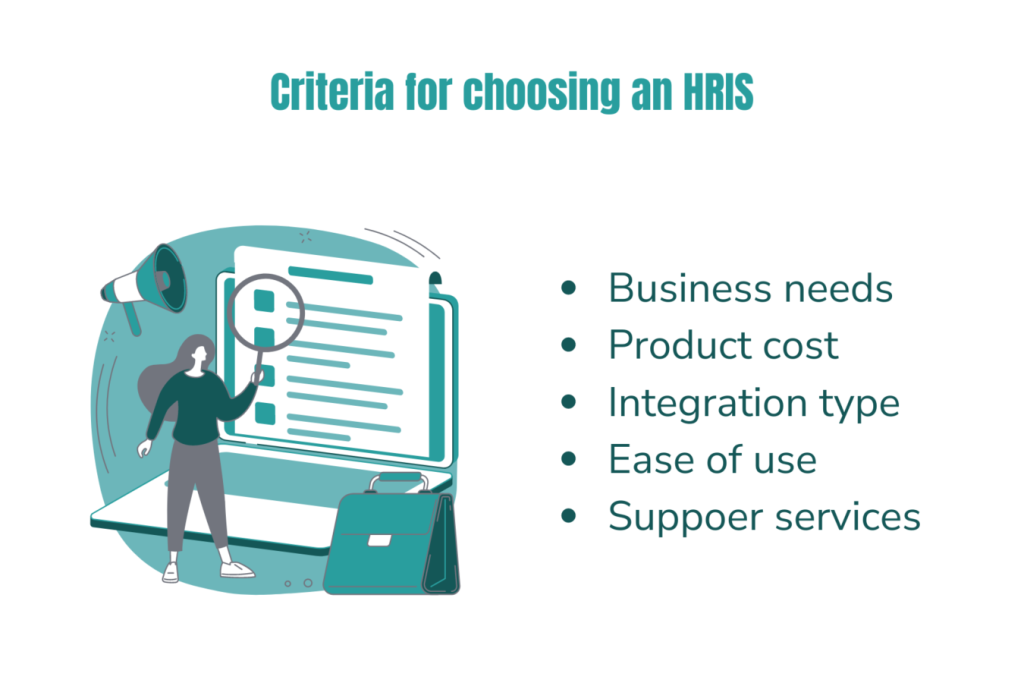
The needs of your business.
One of the most important factors to consider when choosing your HRIS and payroll software solution is whether it provides the necessary functions and features to satisfy your business’s needs. It may be the most attractively designed or popular system, but if it doesn’t answer all your business needs, then it probably isn’t worth it.
The cost of the product.
When choosing your HRIS and payroll software, being stingy and going for the cheapest one might not be the best idea every time, nor will going for the most expensive one. It might just cost a little more to have the system that is best suited for your business. But make sure that purchasing your system doesn’t bore a hole through your budget.
Online or Offline Integration.
You also have to consider whether you want your system accessible anywhere you go or just in your office or business location. If you want it accessible anytime, anywhere, you should use an online or cloud-based system. For the online integration, you might be asked to pay additional for domain hosting, and you won’t be able to access your system if you are not connected to the internet.
If you opt for offline or on-premises HRIS and payroll software, you can only access your system in your office with devices connected to the server. Unlike cloud-based systems, offline systems have physical servers in your office that could still be susceptible to damage.
Ease of Use and Learnability
After finding a system that suits your business needs, is just right for your budget, and offers the type of integration you want, is that enough? For some, maybe. However, a system that is easy to learn and use should also be considered. A system that is hard to use and understand will not be helpful and will only cause you frustration.
Support Services
Another factor to consider when purchasing HRIS and payroll software is the kind of support service the payroll provider provides along with the system. This is important because you might encounter problems with the system that only the provider might solve. Or you may want something modified or added to your system.
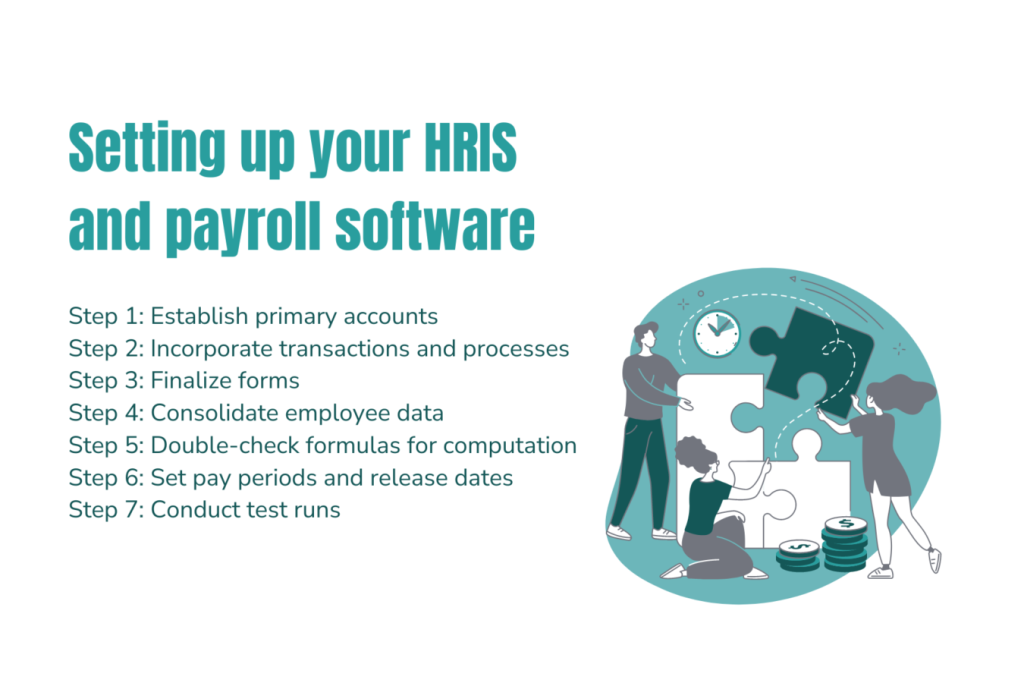
How do you set up HRIS and payroll software?
To have HRIS and payroll solutions, you may get them from companies offering IT and business solutions or acquire them from a payroll service provider. Once you have your chosen system, you must set it up correctly so it can perform its functions accurately.
Step 1: Establish primary accounts
You should ensure that all the needed (primary) accounts are established, then decide on the level of access each account gets in the system. This step guarantees the privacy and security of confidential information within the system. The level of access given to each account may also alter the interface with which each account owner gets to see and interact.
Step 2: Incorporate transactions and processes
Ensure that all necessary transactions and processes are incorporated into the system. You should also ensure that all critical steps of each process are accounted for and that all required data or information is acquired in each step.
Step 3: Finalize forms
Gather and finalize the forms the system will incorporate. You must ensure that all required and optional forms and fields are complete. The forms must also comply with the company’s legal parameters and regulations.
Step 4: Consolidate employee data
Collect all necessary employee data and enter it into the system. Then, create the employee accounts. You must ensure that the data are complete and accurate because the system will be the only source of information about the employees.
Step 5: Double-check formulas for computation
Ensure that you have the correct formulas for computing gross pay, net pay, deductions, contributions, tax withholdings, and other monetary matters. This step is crucial in setting up the HRIS and payroll system, as any mistakes in computing may cripple the company.
Step 6: Set pay periods and release dates
Set the pay period and schedule the pay release dates. This step ensures that the employees get their hard-earned salaries on time, maintains their satisfaction, and gives them a better experience.
Step 7: Conduct test runs
Lastly, you must conduct at least several test runs to ensure that the system is functioning as it should and that all possible scenarios that may arise during its use have been tested. This step also guarantees that any problems are mitigated before the company uses the HRIS and payroll software.
That’s it! After the last step, you now have a well-set-up HRIS and payroll software that is certified to carry out the work of the HR team flawlessly. Or at least as flawless as you have set it up to be.
Emerging Trends and Developments in HRIS and Payroll Processing
The HRIS and payroll technology landscape is rapidly evolving and driven by advancements and changing business needs. Below are the latest trends and developments that are reshaping the way businesses manage their HR and payroll functions.
Cloud-Based Solutions
Cloud-based payroll and HRIS systems are becoming increasingly popular due to their flexibility, scalability, and cost-effectiveness. These solutions allow businesses to access their HR data from anywhere, at any time, providing real-time updates and improving efficiency.
For businesses in the Philippines, cloud-based systems eliminate the need for significant upfront investments in IT infrastructure and reduce ongoing maintenance costs. Additionally, they offer enhanced data security and disaster recovery capabilities, which are critical for protecting sensitive employee information.
Mobile Accessibility
The shift towards mobile accessibility is transforming HR and payroll processes, enabling employees and managers to perform tasks on-the-go. Mobile applications for human resources information system and payroll systems allow employees to check their pay slips, request leave, clock in and out, and update personal information directly from their smartphones.
For businesses in the Philippines, this means increased convenience and productivity, especially for remote or field-based employees. It also facilitates better communication and engagement between HR departments and employees.
AI and Automation
Artificial Intelligence (AI) and automation are revolutionizing HR and payroll functions by automating routine tasks, reducing errors, and providing valuable insights. AI-powered chatbots can handle employee queries, while machine learning algorithms can process payroll data accurately and quickly.
Automation of repetitive tasks such as payroll processing, benefits administration, and compliance reporting frees up HR professionals to focus on strategic initiatives. For businesses in the Philippines, leveraging AI and automation can lead to significant time and cost savings, as well as improved accuracy and compliance with local regulations.
Make your HRIS and payroll transition eezi
Switch to eezi and enjoy the benefits of a compliant, configurable, user-friendly, and straightforward cloud-based HRIS and payroll solution.
